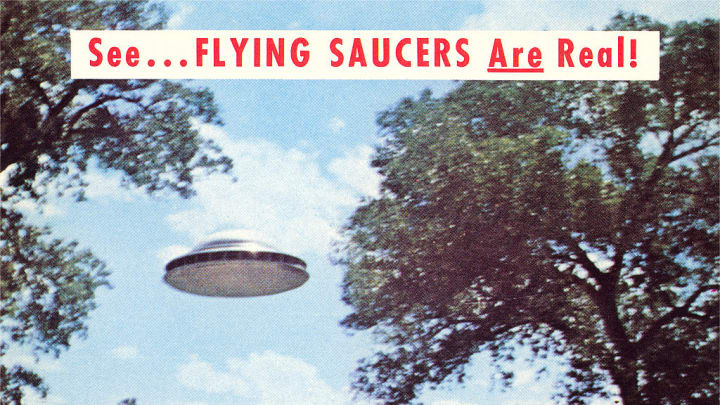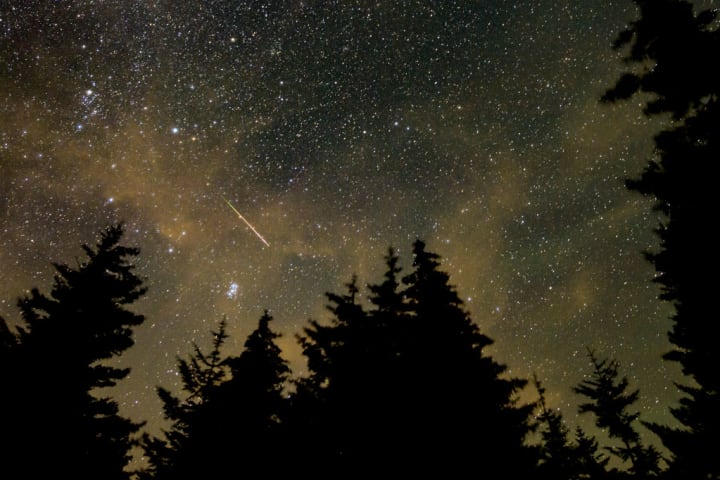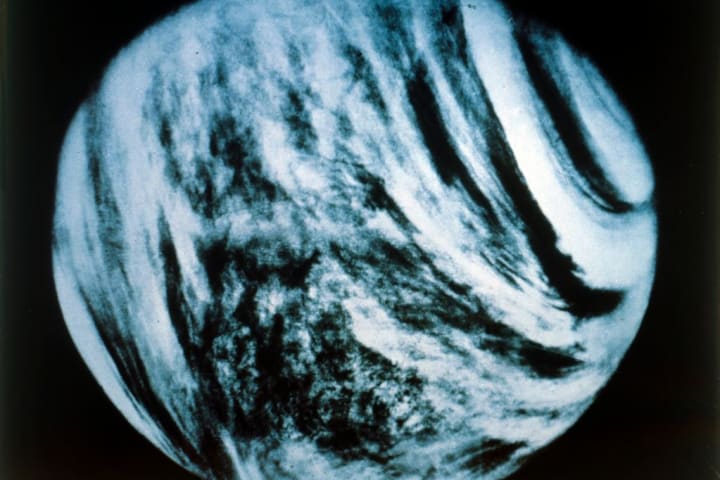24 Fascinating Facts About UFOs
Unidentified Flying Objects, or UFOs, have been fascinating humanity since ancient times (though strange things in the sky weren’t always referred to as UFOs, of course). From bizarre early sightings and the time the White House had a run-in with UFOs to the origin of the phrase flying saucer and the truth behind what happened at Roswell, New Mexico, here are UFO facts you need to know, adapted from an episode of The List Show on YouTube.

UFO stands for Unidentified Flying Object, a term that the Oxford English Dictionary says was coined in 1953 by writer Donald Keyhoe in an issue of Air Line Pilot. In the article, though, Keyhoe mostly uses the term in quotes from Air Technical Intelligence Center reports, which is part of the U.S. Air Force. In a document from the ‘50s, they defined a UFOB as “any airborne object which by performance, aerodynamic characteristics, or unusual features, does not conform to any presently known aircraft or missile type, or which cannot be positively identified as a familiar object.” Things that fall into the category of familiar objects include balloons, birds, and planets.
UFO isn’t the only acronym used to refer to these crafts. A recently released government report uses UAP, or Unidentified Aerial Phenomenon, amongst other creative abbreviations.
Just because we call something a UFO doesn’t necessarily mean there are aliens involved, although of course the two terms are associated in the public consciousness. But if you do want to talk about little green men and sound super official about it, you can call them ETBs, or extraterrestrial beings. There are also ETCs, or Extraterrestrial Crafts.
These terms, by the way, come from an NSA list of terms included in unsuccessful Freedom of Information Act requests. If you were curious, yes, people did want government documents containing the word ALF.

You know Foo Fighters as a totally badass rock band headed up by Dave Grohl, but the term dates back to World War II. The word foo seemingly originated from Smokey Stover, a popular comic at the time; members of the 415th Night Fighter Squadron paired it with the word fighters to describe the weird, annoying balls of light they spotted in the air over Germany. Grohl was apparently reading a lot of books about UFOs at the time, and—take note, wannabe rock stars—he has said that “there’s a treasure trove of band names in those UFO books!”

The phrase flying saucer has a pretty fascinating history. It seems to have gotten its big break after an incident that occurred on June 24, 1947. Pilot Kenneth Arnold was flying near Mount Rainier looking for plane wreckage when he spotted nine metallic objects in the sky. They were huge—Arnold estimated they were each about the size of a DC-4 plane—and moving around 1200 mph. He thought they were military planes and reported them, at which point the press misquoted him as saying the objects were “flying saucers.” As Arnold recalled in an interview with legendary journalist Edward Murrow:
“These objects more or less fluttered like they were, oh, I’d say, boats on very rough water or very rough air of some type, and when I described how they flew, I said that they flew like they take a saucer and throw it across the water. Most of the newspapers misunderstood and misquoted that too. They said that I [had] said that they were saucer-like; I said that they flew in a saucer-like fashion.”
The misquote took flight, you might say; in the weeks afterward, flying saucers were spotted in 40 other states. And for a time, the phrase was basically shorthand for a UFO.
The article, which was called “Have We Visitors From Space?,” appeared in an April 1952 issue of LIFE and featured 10 UFO cases that, in the opinion of one scientist quoted in the article, “have an out-of-world basis.” As evidence of their extraterrestrial origins, he cited things like the acceleration ability of the aircrafts and the fact that no human pilot could survive the maneuvers they pulled off.
Long before either Kenneth Arnold or LIFE, people were spotting UFOs in the skies—and either drawing them or writing about them. As Richard Stothers put it in a 2007 piece for The Classical Journal, “Throughout recorded history, reports of what we today might call unidentified flying objects have been made and preserved. If more information were available to us, we would perhaps find that conventional scientific hypotheses could explain most, if not all of these … There nonetheless remains a small residue of puzzling accounts, and regardless of what interpretation one places on them, these constitute a phenomenon that spans centuries of time and widely different cultures.”

In that Classical Journal paper, Stothers focused on the Ancient Romans, who wrote about strange things in the sky all the time. Some of them can definitely be explained by natural phenomena, like eclipses or meteor showers. Others, not so much.
In 74 BCE, thousands of people witnessed a strange event in which, as Plutarch wrote around 150 years later, “a huge, flame-like body,” silver in color and shaped like a wine jar, interrupted two warring armies. Pliny the Elder wrote that “a spark was seen to fall from a star and to grow as it approached the earth.” It eventually became as large as the Moon before going back into the sky. And in the 200s BCE, there were reports of things like “a spectacle of ships” and “round shields” seen in the sky.
Things don’t get any less weird when you fast forward to the 1560s, when people living in Germany and Switzerland reported seeing strangely shaped objects doing aerial battle and flying around.

The first written record of UFOs in what eventually became the United States comes from the 1630s, when some men who were out on Boston’s Muddy River at night reported seeing a light in the sky. In the words of Governor John Winthrop, who recorded the incident, “when [the light] stood still, it flamed up, and was about three yards square; when it ran, it was contracted into the figure of a swine: it ran as swift as an arrow towards Charlton [Charlestown], and so up and down about two or three hours.”
Even stranger, by the time the incident was over, the boat the men were in had somehow moved a mile upstream—and they weren’t sure how that had happened.
After World War II, modern UFO research really ramped up. Sightings of weird things in the sky spiked, and the government responded by having the U.S. Air Force investigate the incidents. The Air Force formed the first of several task forces, Project Sign, in 1948. It was quickly succeeded by Project Grudge, which itself was superseded by the most famous UFO inquiry, Project Blue Book, in the early 1950s.

At some point in the summer of 1947, something crashed on a ranch outside of Roswell. The rancher who discovered the debris said it was “bright wreckage made up of rubber strips, tinfoil, a rather tough paper and sticks.” In early July, he delivered some of the debris to the sheriff, who called in the big guns: the military. Men based at the Roswell Army Air Field went out to collect the rest of the debris, and soon, their press representative released a statement, which said:
“The many rumors regarding the flying disc became a reality yesterday when the intelligence office of the 509th Bomb Group of the Eighth Air Force, Roswell Army Air Field, was fortunate enough to gain possession of a disk through the cooperation of one of the local ranchers and the sheriff’s office of Chaves County.”
The statement made news around the country, even as the Army was backpedaling. As Dick Pearce at the San Francisco Examiner reported on July 9, 1947, he called General George Ramey at a base in Fort Worth, Texas, who described the disc and noted his belief that it was a piece of a weather balloon, saying, “There is no such gadget (as the disc) known to the Army—at least this far down the line.”
Pearce described the initial statement as “the boner of” the Army’s public relations official and wrote that the debris was actually “the box kite radar reflector of a weather balloon,” noting, “while the mistake lasted, it was a honey.”
For a while, that was that—until the 1970s, when people who believed the government was covering something up started casting doubt on the official story. And in a way, they weren’t wrong. What crashed outside Roswell may not have been extraterrestrial in origin, but it also wasn’t a weather balloon—most likely, it was part of Project Mogul, which was an experimental project to acoustically spy on the Soviets.
To handle UFO sightings, Project Blue Book—which was was named after those little blue books students took college exams in—asked people to fill out standardized questions, including “When did you see the object?” “Where were you when you saw the object?” “What was the condition of the sky?” and “If there was more than one object, then how many were there?” UFO spotters were also asked to draw what they had seen, describe what sound it made, and note if its edges were fuzzy, bright, or sharply outlined.
Project Blue Book was active until 1969 and in that time, according to Britannica, recorded 12,000 incidents which were either identified—as things like atmospheric phenomena or man-made objects like weather balloons—or “unidentified.” The unidentified incidents accounted for 6 percent of the cases recorded by Project Blue Book.

Not long before midnight on July 19, 1952, seven weird blips appeared on the radar of Washington National Airport, leading the man in the air traffic control tower to crack a joke about “a fleet of flying saucers.” Soon, air traffic controllers at Andrews Air Force base were also seeing strange blips moving at incredibly high speeds on their screens. But no one was laughing when those crafts, whatever they were, flew by the Capitol Building and the White House.
By the time interceptor jets were mobilized back on that day in July 1952, whatever craft had paid a visit to a snoozing Harry S. Truman had disappeared. But according to most versions of the story, when the planes left, the blips came back. When night ended, they left—and then came back again the following Saturday. Jets were called up again, but just when they would get to an area where the blips had been seen on radar, the blips would vanish from radar.
The incident was officially blamed on temperature inversion, an event in which—simplistically speaking—a layer of warm air traps cooler air underneath; radar signals bounce off the layer and appear to show objects that are actually near the ground in the sky. But the radar operators who saw the phenomenon, as well as the people behind Project Blue Book, didn’t accept that explanation, and what really happened remains unsolved to this day.
Betty worked in child welfare, and Barney at the post office, and in September 1961, they spontaneously decided to take a vacation to give themselves a little R&R. They took a three-day trip, driving from their home in New Hampshire to Niagara Falls and Montreal. On the way back, they were driving on dark, empty roads of New Hampshire’s White Mountains when they spotted a light in the sky that moved strangely—it moved upward instead of falling like a shooting star would. It got bigger and bigger, and eventually seemed to be keeping track of their car as they drove. When they looked at it through binoculars, they could see that it was a spinning object.
They kept driving, but eventually, Barney had had enough. He got out to confront the craft and saw grayish aliens inside with huge eyes. He felt like they were going to be abducted, so he ran back to the car and hit the gas. As they continued to drive, the Hills encountered some kind of roadblock and a fiery orb and passed out.
When they woke up a couple of hours later, they were 35 miles away from where they’d been with zero memory of how they’d gotten there. Their clothes and shoes were mussed, and their watches weren’t working. There were strange metal marks on the trunk of their car that made compasses go wild.
Understandably disturbed, the Hills filed a report with Project Blue Book and went to a psychiatrist, who used hypnosis to help them remember what supposedly happened: Gray beings took them into a huge metallic craft, where they were separated and examined. The beings took samples of their hair, nails, and skin, and a needle was inserted into Betty’s abdomen. Finally, their memories were erased.
The Hills didn’t tell anyone about the incident until 1963. Ultimately, despite therapy, research, and getting the government involved, the Hills didn’t find out what had happened to them. Many have been skeptical of their accounts, of course, including a young Carl Sagan, who, in 1967, was a Harvard professor on a panel discussing the possible abduction. Project Blue Book officially filed their case under “insufficient data.”

Venus, for example, is a prime culprit behind many supposed UFO sightings, probably because it’s so bright and so close to the horizon. SpaceX rocket launches have been mistaken for UFOs, and so has an Army parachute team. Drones and certain cloud formations also make the list. One UK resident actually called the police to report a bright object lingering near their home … which they later realized was the Moon.
The report, released by the Unidentified Aerial Phenomena Task Force, or UAPTF, focused on 144 eyewitness reports of UAPs—unidentified aerial phenomena—reported by government employees, which occurred between 2004 and 2021.
Of those 144 cases, the report identified just one with confidence: It was believed to be a very big balloon that was deflating. The rest remain unidentified.
There were themes that emerged in the eyewitness accounts, including things like size, shape, and propulsion. There was also the fact that sightings often occurred around U.S. military testing grounds, but the report notes that that might be because of large numbers of high-quality sensors in those locations and because aviators there are both more focused and encouraged to report anomalies.
In some of the incidents, witnesses reported UAPs that moved in unusual ways. According to the report, “Some UAP appeared to remain stationary in winds aloft, move against the wind, maneuver abruptly, or move at considerable speed, without discernible means of propulsion. In a small number of cases, military aircraft systems processed radio frequency (RF) energy associated with UAP sightings.”
Does this mean aliens? Of course not, according to the task force. In fact, they think many of them will fall into a few explainable categories: airborne clutter (think things like that aforementioned balloon, birds, or drones); natural atmospheric phenomena (things like moisture and ice crystals); USG or Industry Developmental Programs (a.k.a. classified aircraft); or foreign adversary systems (craft deployed by the likes of Russia or China).
All the rest end up in the “other” category. And even then, as one official said, “we have no clear indications that there is any non-terrestrial explanation for them—but we will go wherever the data takes us.” These objects might have appeared to move strangely because of observer misperception or things like sensor errors.
We don’t have an explanation for these sightings yet, and unfortunately, it might stay that way, thanks to things like insufficient data and limited reporting. That said, because these UAPs could pose a risk to military aircraft and national security, these reports will continue to be collected and studied. So the truth … might still be out there.


